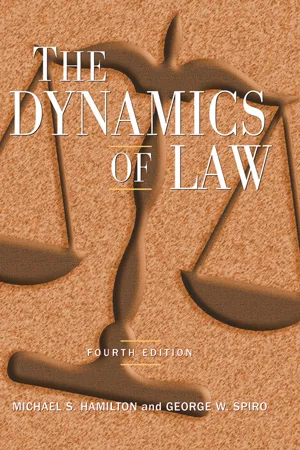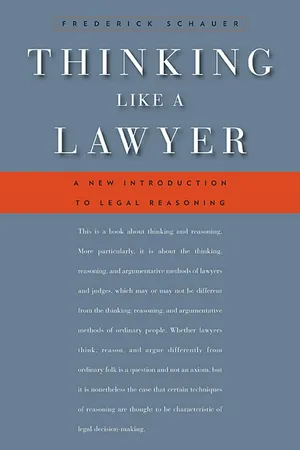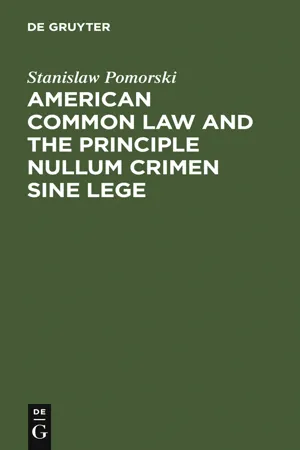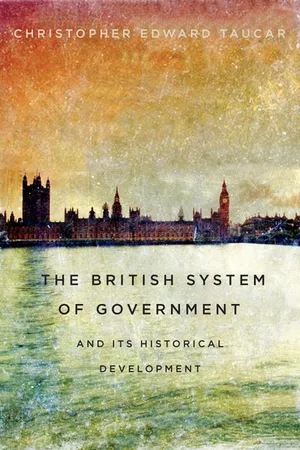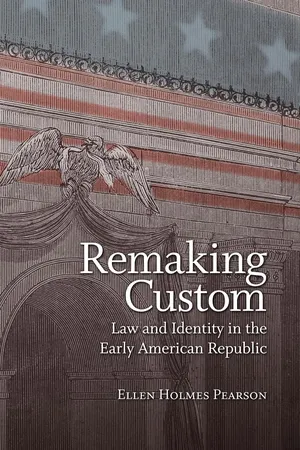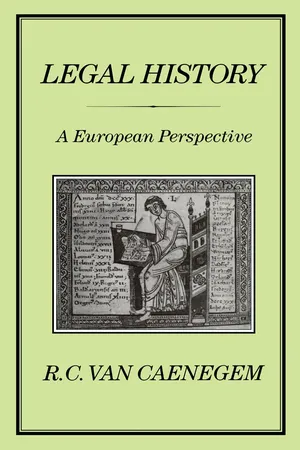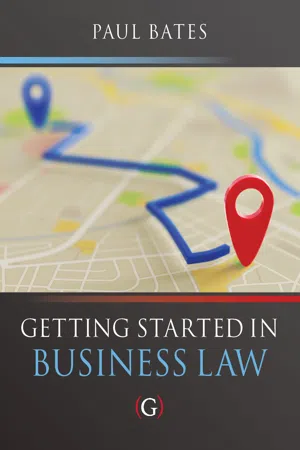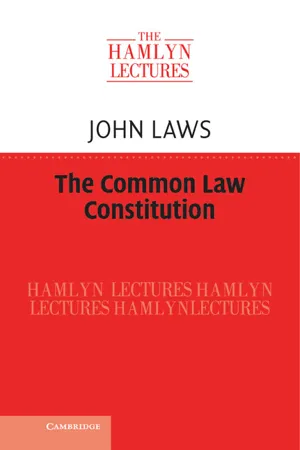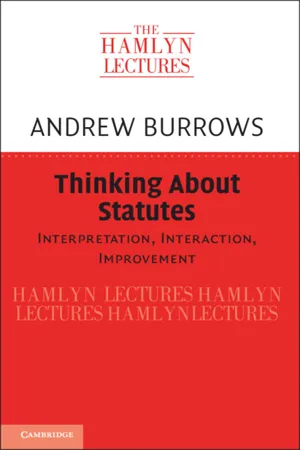Law
Common Law
Common law refers to a legal system based on judicial decisions and customs, rather than on written laws. It is developed and refined over time through court decisions and precedents. Common law principles are used in many English-speaking countries, including the United States, and form the basis of the legal system in those jurisdictions.
Written by Perlego with AI-assistance
10 Key excerpts on "Common Law"
- eBook - ePub
- Michael S Hamilton, George W Spiro(Authors)
- 2014(Publication Date)
- Routledge(Publisher)
Common Law —“common” because it was common to all of England.The term Common Law , you will discover, is used in several slightly different senses.Most broadly, the term is used to designate the Anglo-American legal tradition, which also prevails in most other English-speaking countries. This tradition is often contrasted with the civil-law tradition, which derives from Roman law and prevails today in the countries of continental Europe and some others. Common Law is also generally used, as here, to distinguish a body of rules originally administered by the royal courts of law from the rules of equity administered by the Court of Chancery (discussed below). Sometimes the word law alone is also used in this sense.The term Common Law is also often used to refer to all judge-made rules built on precedents, as distinguished from legislative enactments and decisions in which these enactments are interpreted. The phrase “At Common Law, the rule was that…” refers to a decisional rule that prevailed before passage of some statute. For well over a century, this process of judicial lawmaking provided England with virtually all its legal rules for channeling private conduct. It was not until the late thirteenth century that enacted law—first royal edicts and then acts of Parliament—became a significant element in English law. Lastly, the term Common Law occasionally refers to the body of English rules that was transplanted to the American colonies and was in force in 1776 when the colonies claimed their independence.Emergence of Equity
By the fourteenth century, certain deficiencies had begun to appear in the justice being dispensed by royal courts. Would-be plaintiffs found themselves increasingly baffled and thwarted by rigid, highly technical procedural requirements. Moreover, the royal courts tended to confine themselves to redressing wrongs by awarding money damages to the person wronged. Money was not always an adequate remedy. Little by little, plaintiffs dissatisfied with the treatment they received from the royal courts began to petition the king for some other form of redress. The king adopted the practice of turning these petitions over to the Lord Chancellor, a high official in the king’s court. By the latter part of the fifteenth century, this practice had become institutionalized, and the chancellor (now presiding over a new Court of Chancery) was issuing decrees on his own authority. The body of principles and remedies developed by the Court of Chancery came to be known as equity - eBook - PDF
Thinking Like a Lawyer
A New Introduction to Legal Reasoning
- Frederick Schauer(Author)
- 2009(Publication Date)
- Harvard University Press(Publisher)
F. C. Milsom, A Natural History of the Common Law (2003); S. F. C. Milson, Historical Foun-dations of the Common Law (2d ed., 1981); Theodore F. T. Plucknett, A Concise History of the Common Law (5th ed., 1956); Gerald J. Postema, “Classical Com-mon Law Jurisprudence,” 2 Oxford Commonwealth L.J. 155 (2003), 3 Oxford Commonwealth J.J. 1 (2003). their legal traditions to Roman law and the French Napoleonic Code, as well as from Islamic law, Chinese law, socialist law, and the legal systems of several additional legal families. The characteristic feature of the Common Law in its purest form—the archetype, but not the reality—is the absence of a master code of laws. The countries of the common-law world have inherited from England a legal system in which written-down rules are less important than the popular rulebook image of law has it, and in which judge-made law— law created in the process of deciding particular disputes—occupies cen-tral stage. In the pure common-law system, one that exists far more as caricature than as an accurate depiction of any actual legal system, judges are expected to adjudicate particular disputes, and to do so with-out reference to statutes or any other kind of written rule. The judges make their decisions on the basis of their own sense of fairness, reason-ableness, custom, and good policy and then provide reasons for their de-cisions. By virtue of the operation of a system of precedent and law re-porting, future courts then learn about what earlier courts have done, and over time areas of law develop without there ever having been a code, statute, or regulation. The law is made by the judges. Thus, when people refer to case-by-case lawmaking, they are referring largely to the central method of the Common Law, one in which law is created incre-mentally in the process of adjudicating particular disputes and in which there may never have been a crisp and canonical formulation of a specific legal rule. - Stanislaw Pomorski(Author)
- 2012(Publication Date)
- De Gruyter Mouton(Publisher)
THE CONCEPT OF PRECEDENT IN THE Common Law SYSTEMS As we mentioned earlier the Common Law was born and de-veloped in England. A product of the central Royal Courts, it was created during the twelfth and thirteenth century. These courts gradually ousted the local laws and imposed throughout the country the law made by themselves. Thus, right from the beginning, judicial decisions were the main substance of the Common Law. 11 In the initial stage precedent played an 10 Fifty state jurisdictions, the federal jurisdiction and four more: the District of Columbia, the Commonwealth of Puerto Rico and two Territories: Virgin Islands and Guam. Comp.: Ε. Griswald, Law and Lawyers in the United States, Cambridge, Mass., 1964, p. 2. 11 C. K. Allen, Law in the Making, 7th ed., Oxford, 1964, pp. 187-190; T. F. T. Plucknett, A Concise History of the Common Law, 5th ed., Boston, 1956, pp. 343-346. 35 important role as the proof of the existence of an established practice, as an illustration of the judicial custom according to which cases were solved in a certain manner. A single prec-edential decision did not however have the force of law. So, for several centuries the Common Law was the customary law of the courts rather than a judicially enacted law. The binding character of single precedents was established in the course of a long evolutionary process and first crystallized as a bind-ing principle in the English and American legal systems in the nineteenth century. 12 Henceforth the Common Law ceased to be the customary law of the court and became a law enacted by the court. The Common Law rule attains its present force not because the courts u s e d t o a p p l y it but because it w a s e s t a b l i s h e d by a binding decision. The classics of the English legal literature such as Hale and Blackstone answered in the negative the question whether prec-edents are the source of the Common Law.- Christopher Edward Taucar(Author)
- 2014(Publication Date)
- McGill-Queen's University Press(Publisher)
Second, the Common Law was not boundless, and under judicial authority alone it was not expandable, at least significantly, nor was it even capable of dealing with all disputes. Rather, the Common Law became a bounded and limited jurisdiction as the courts became independent and separated from Curia or Council.Finally, there is a connection between the Common Law and the constitution in the sense that the Common Law contained law relevant to the government machinery and its constitution. Judges’ decisions on these matters were not applying a ‘fundamental’ law in the sense of a written Constitution higher than parliamentary legislation, but were applying statute and Common Law to governmental bodies. For example, eighteenth-century statutes dealing with local government were interpreted and applied by justices of the peace and courts of Common Law. Therefore, the statutes were worked into the technical system of Common Law; and, in cases involving government based on Common Law principles, statute law and Common Law were fused together.CourtsCourts held before royal judges differed from communal courts and the general body of the king’s court. Royal judges formed the court. When the king’s interests were concerned, royal control was strict. When not, royal judges were influenced by the fact that they began to sit as regular tribunals at a time when the idea became current that the suitors of the court were the true exponents of the law. This idea emphasized the dominant medieval view that law should reign supreme, and led judges to regard the exposition of law as emanating from the court rather than from the king. They were royal judges bound to obey royal commands, but they were also judges beginning to create law, as discussed, which was within their delegated jurisdiction, and at a time when it seemed natural that the court should expound the law. This idea with respect to the position of law tended to give it a practical independence.107- eBook - PDF
Remaking Custom
Law and Identity in the Early American Republic
- Ellen Holmes Pearson(Author)
- 2011(Publication Date)
- University of Virginia Press(Publisher)
To overstate the importance of custom to English social and legal cultures is difficult. The idea that the English Common Law was born out of immemorial custom was deeply ingrained in the English consciousness, and the Common Law’s abil-ity to endure across the ages was a source of great pride for Englishmen. Habitual usage was, to the English mind, the most perfect litmus test of a regulation. If a practice could hold up to years of use without rejection by the governed, it carried considerable legal authority among the English. Americans shared English pride in their common legal tradition, and they too emphasized the importance of custom, particularly in giving substance and strength to a constitution and law seemingly without beginning. 17 The idea of an ancient, unwritten law was so much a part of Anglo-Amer-ican culture that it was difficult, if not impossible, for many to imagine liv-ing without it. Decades after the Revolution, Americans’ attachment to the Common Law was still strong. In an 1824 address to the incoming law stu-dents at the College of Philadelphia, French-born lawyer Peter DuPonceau stated that the Common Law was “interwoven with the very idiom that we speak . . . we cannot learn another system of laws without learning at the same time another language.” He called the Common Law “a metaphysical be-ing,” grown out of feudal customs that had gradually “become incorporated and in a manner identified not only with the national jurisprudence, but, under the name of Constitution, ” with America’s government. DuPonceau’s inclusion of elements of the Common Law within “every civil and political institution, and every thing connected with the government of the country,” 16 | Remaking Custom stretched the Common Law’s influence into the daily lives of every Ameri-can citizen. - eBook - PDF
LEGAL HISTORY
A European Perspective
- R. C. Caenegem(Author)
- 1990(Publication Date)
- Hambledon Continuum(Publisher)
Even the last adjective is not entirely inappropriate, because no less than Sir Frederick Pollock believed in 'the divinity that shapes our ends' as the final explanation for the unique majesty of English law. 19 This was the real 'common right and reason', the true law, which was best left alone by the legislator. It is exactly what Sir Edward Coke pronounced in Bonham's case in 1610: Tt appears in our books that in many cases the Common Law will control Acts of Parliament and sometimes adjudge them to be utterly void: for when an Act of Parliament is against common right and reason, or repugnant, or impossible to be performed, the Common Law will control it and adjudge such Act to be void'. 20 This Common Law, he continued, had been 'refined and perfected by all the wisest men in former succession of ages' 21 and its history was regarded therefore, as Baker says, as a 'slow revelation and refinement of doctrines essentially immutable'. 22 In the early 70s, Lord Reid remarked ironically on the idea that 'in some Aladdin's cave there is hidden the Common Law 18 Chief Justice Markham was dismissed from the King's Bench in 1469 because he refused to twist the law in order to pronounce a condemnation for treason (Holdsworth, Makers, p. 56). James I treated his judges as officials and servants of the crown just like all the others (op. cit., p. 115) and even dismissed Sir Edward Coke. The king moreover saw himself as the supreme judge, maintaining that 'the King being the author of the Law is the Interpreter of the Law' (K.M. Schonfeld, Montesquieu en 'la bouchede la loi', Leiden, 1979), p. 42); as 'judex' the king is the 'lex loquens' and the 'lex animata' (op. cit., pp. 44, 54). The irremovability of the judges was declared in the Act of Settlement of 1701. 19 The Expansion of the Common Law, London, 1904, pp. - eBook - PDF
Hong Kong's Court of Final Appeal
The Development of the Law in China's Hong Kong
- Simon N. M. Young, Yash Ghai(Authors)
- 2013(Publication Date)
- Cambridge University Press(Publisher)
Chief Constable of Sussex Police [2008] EWCA Civ 39, [45] (CA). 36 Wainwright v. Home Office [2004] 2 AC 406 (HL). the Common Law 337 foundation of other British colonies. 37 In substance, they enacted that the English Common Law and statutes at a particular date should be the law of the particular colony unless conditions in the colony were such as to make them inapplicable. As Bokhary PJ has noted, 38 one consequence of the 1844 and 1870 provisions was that Hong Kong courts had to develop a Common Law of Hong Kong even though it was for the most part identical to English Common Law. This position was not altered by the Application of English Law Ordinance of 1966. 39 The Common Law is not a fixed system of immutable rules. Rather, it has an inherent capacity to grow and develop by responding to changed circumstances even by correcting its own mistakes. If we look at the English Common Law through the lens of history, we perceive how its rules and principles have developed and changed over its long life of more than 800 years. We also perceive that the change has been slow, seemingly imperceptible in a short time span. So it is with Article 8, as it was in 1844, 1870, and 1966, that the Common Law to which it refers is a Common Law capable of development by the courts. Because the Privy Council (PC) was the final court of appeal from the courts of Hong Kong before 1 July 1997, decisions of the PC on appeals brought from Hong Kong, by virtue of the doctrine of prece- dent, were binding on the courts of Hong Kong. Although decisions of the PC on appeals brought from other jurisdictions were not bind- ing on the Hong Kong courts, 40 these decisions were so persuasive and influential that they would be invariably followed in Hong Kong unless local circumstances were materially different. The same comment may be made about decisions of the House of Lords. - eBook - PDF
- Paul Bates(Author)
- 2021(Publication Date)
- Goodfellow Publishers(Publisher)
The final and successful invasion was in 43 A.D. The truth of the matter is that the Romans didn’t really try to force their systems of law upon the ordinary people living in the land at this time. They were quite happy to accept the law that they found already existing here. This mistake I think is often made as there is so much use of the Latin language in law. For the reason why this is the case see Chapter 1, ‘ What you need to know ’. Unfortunately, the expression ‘Common Law’ can have more than one meaning. This doesn’t really matter very much as long as you’re aware that different writers sometimes are referring to different definitions of what they mean by Common Law. It’s used at times to refer to law which was historically made in the early court system after 1066 following the Norman Conquest, as opposed to Getting Started in Business Law 36 ‘equity’ which was developed later in an attempt to improve the older system. Equity it has been often said, is “a gloss on the Common Law”. More on this below. Sometimes the expression is used for law made by judges in order to dis-tinguish judge-made law from law made by Parliament (Legislation) The Law of Equity Equity is just another word meaning fairness. The Common Law, and here I am using the term to mean to the law made by judges which eventually became common throughout the land, was to be truthful, pretty basic and ‘rough and ready’. Actually, it still is. Most people centuries ago didn’t have access to the law at all unless they happened to be very rich (what’s changed?). Originally if you wanted to obtain a remedy for some legal wrong which you’d suffered, then you had to obtain an official document (called a writ simply because it was a piece of paper where your complaint was written). A writ was very difficult and very expensive to obtain. If the legal complaint you wanted to take action upon was not covered by an existing writ, then you had no remedy available to you. - eBook - PDF
- John Laws(Author)
- 2014(Publication Date)
- Cambridge University Press(Publisher)
I can see that there may appear to be an unbridgeable divide between the views of Common Law constitutionalists such as Trevor Allan and the loyalists of 31 See in particular, Law, Liberty and Justice: The Legal Foundations of British Constitutionalism (Oxford, Clarendon Press, 1993). 32 Ibid. p. 17. 33 Goldsworthy, The Sovereignty of Parliament, n. 8 above, esp. pp. 247–77. 34 Ibid. p. 263. 35 Law and Disagreement (Oxford University Press, 1999). 36 Ibid. p. 15. the Common Law and state power 27 sovereignty such as Jeffrey Goldsworthy. The pull towards sovereignty is that someone has to be Master, and the Master should be the people’s representatives. The pull against it is that the all-powerful democracy may trample over fundamen- tal rights and freedoms. But the issue need not be seen in the contours of so stark a contrast. Sovereignty may readily acknowledge practical limits, accepted in the name of reason, fairness and the presumption of liberty. They are the gifts of the Common Law. This is key to a proper understanding of parliamentary sovereignty. It marches with the reasoning of John McGarry of Edge Hill University in a very interesting recent article in the Journal of the Society of Legal Scholars. 37 Legislative supremacy is not a doctrine set in stone. It is an evolving legal construct: a principle, not a rule. Granted that, at the least, the reach or scope of the doctrine has been honed and conditioned by the Common Law, we should understand that the Common Law’s fourfold method applies to its development as well as to that of any other legal sphere. Where a clash seems to loom between the claims of the sovereign legislature and those of deep individual rights, it will time after time be resolved by recourse to interpretation, and therefore by the methods of the Common Law. - eBook - PDF
Thinking about Statutes
Interpretation, Interaction, Improvement
- Andrew Burrows(Author)
- 2018(Publication Date)
- Cambridge University Press(Publisher)
Lecture 2 The Interaction between Common Law and Statute As Professor Guido Calabresi said in his book, A Common Law for the Age of Statutes, 1 we are ‘choking on statutes’. 2 In Grant Gilmore’s graphic description, for the past century and more, there has been ‘an orgy of statute-making’. 3 And in the words of Professor Robert Stevens, ‘Judge-made rules are . . . doomed to die . . . Eventually legislation will cover all, as far as the eye can see.’ 4 Of course, in Common Law systems, our basic law is judge-made. Statutes are seen as supplementing or removing the Common Law but it is the Common Law that provides the residual gapless law where there is no statute. So whatever the factual takeover of the Common Law by statute, and hence the factual dominance of statutes, in a conceptual sense, our Common Law remains the primary source of law. This contrasts with civilian systems where a statutory code is seen as providing the basic gapless law. 5 1 Guido Calabresi, A Common Law for the Age of Statutes (Harvard University Press, 1982). 2 Ibid. at 1. 3 The Ages of American Law (1977) at 95. 4 ‘Private Law and Statute’ at 1 (paper given at conference on Private Law in the 21st Century, Brisbane, 2015). 5 For a fascinating insight into the creation of the French Code Civil, see the editorial notes of Professor Thomas Barnes to the Legal Classics version 45 However, the relative neglect of the study of statutes in a Common Law system is only partly to be attributed to the conceptual centrality of the Common Law. It is also because, at least on the face of it, cases are so much more interesting and entertaining than statutes. As lawyers in the Common Law tradition, we are never happier than when we have cases to learn from. Case law is fun because we have a real-life situa- tion at the forefront of attention.
Index pages curate the most relevant extracts from our library of academic textbooks. They’ve been created using an in-house natural language model (NLM), each adding context and meaning to key research topics.
